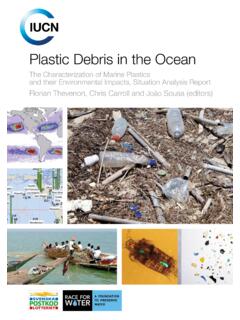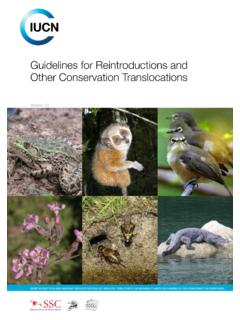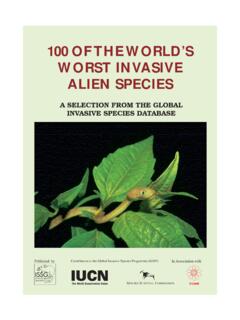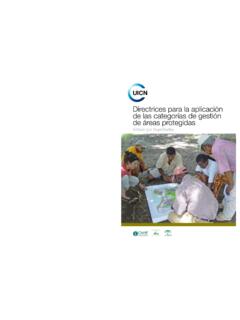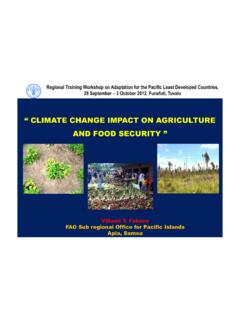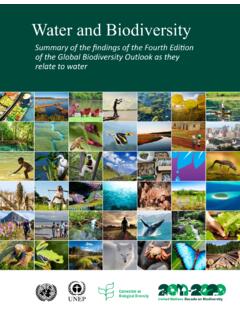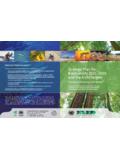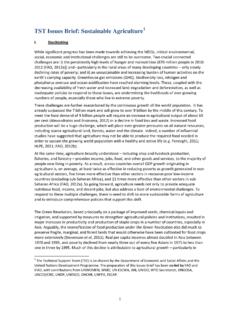Transcription of Guidelines for planning and monitoring corporate ...
1 IUCN GLOBAL BUSINESS AND biodiversity PROGRAMMEG uidelines for planning and monitoring corporate biodiversity performanceAbout IUCN IUCN is a membership Union uniquely composed of both government and civil society organisations. It provides public, private and non-governmental organisations with the knowledge and tools that enable human progress, economic development and nature conservation to take place together. Created in 1948, IUCN is now the world s largest and most diverse environmental network, harnessing the knowledge, resources and reach of more than 1,400 Member organisations and some 15,000 experts. It is a leading provider of conservation data, assessments and analysis. Its broad membership enables IUCN to fill the role of incubator and trusted repository of best practices, tools and international standards.
2 IUCN provides a neutral space in which diverse stakeholders including governments, NGOs, scientists, businesses, local communities, indigenous peoples organisations and others can work together to forge and implement solutions to environmental challenges and achieve sustainable development. for planning and monitoring corporate biodiversity performanceThe designation of geographical entities in this book, and the presentation of the material, do not imply the expression of any opinion whatsoever on the part of IUCN concerning the legal status of any country, territory, or area, or of its authorities, or concerning the delimitation of its f rontiers or boundaries. The views expressed in this publication do not necessarily reflect those of IUCN.
3 IUCN is pleased to acknowledge the support of its Framework Partners who provide core funding: Ministry of Foreign Affairs of Denmark; Ministry for Foreign Affairs of Finland; Government of France and the French Development Agency (AFD); the Ministry of Environment, Republic of Korea; the Norwegian Agency for Development Cooperation (Norad); the Swedish International Development Cooperation Agency (Sida); the Swiss Agency for Development and Cooperation (SDC); and the United States Department of State. This publication has been made possible by funding f rom IUCN-US, Boskalis and by: IUCN, Gland, Switzerland Copyright: 2021 IUCN, International Union for Conservation of Nature and Natural Resources Reproduction of this publication for educational or other non-commercial purposes is authorised without prior written permission f rom the copyright holder provided the source is fully acknowledged.
4 Reproduction of this publication for resale or other commercial purposes is prohibited without prior written permission of the copyright holder. Citation: Stephenson, and Carbone, G. (2021). Guidelines for planning and monitoring corporate biodiversity performance. Gland, Switzerland: : 978-2-8317-2102-6 (PDF)DOI: : Tanya PetersenDesign and layout: Imre Sebesty n, jr / Unit GraphicsCover illustration: Imre Sebesty n, jrAvailable f rom: IUCN (International Union for Conservation of Nature) Global Business and biodiversity Programme Rue Mauverney 28 1196 Gland Switzerland Email: for planning and monitoring corporate biodiversity performance iiiTable of contentsExecutive summary.
5 VAcknowledgements .. viiiKey terms used in the Guidelines ..ixGlossary of other terms used .. xAcronyms .. xiii1. Introduction .. Linking biodiversity and business activities .. A corporate -level biodiversity strategic plan to support corporate -level biodiversity performance .. Target audience and expectations .. Structure of the Guidelines ..62. The four-stage approach .. 9 Stage 1: Understand the company s impact on biodiversity and identify priority species, habitats and ecosystem services .. 11 What the company needs to do .. 111A. Define the corporate scope of biodiversity influence and identify which company operations, affect or depend on biodiversity .. 111B. Identify the pressures and dependencies associated with company operations.
6 121C. Identify the most important pressures and dependencies on biodiversity the company will tackle ..161D. Identify priority species, habitats and ecosystem services .. 22 Expected outputs .. 27 Stage 2: Develop corporate biodiversity vision, goals and objectives and identify key strategies to deliver them .. 30 What the company needs to do .. 302A. Develop a vision ..312B. Decide on the relevant aggregation unit for planning and monitoring ..312C. Define goals and objectives .. 322D. Identify strategies to deliver corporate goals and objectives .. 342E. Summarise the results so far .. 35 Expected outputs .. 37 Stage 3: Develop a framework of linked core indicators that allows data aggregation at corporate level.
7 38 What the company needs to do .. 383A. Define state and benefit indicators against goals .. 393B. Define pressure and response indicators against objectives and strategies .. 423C. Bring together the elements of a biodiversity strategic plan .. 46 Expected outputs .. 47iv Guidelines for planning and monitoring corporate biodiversity performanceStage 4: Collect, share and analyse data, learn lessons and adapt ..48 What the company needs to do .. 484A. Develop and implement a monitoring plan and collect data ..484B. Share data in formats that facilitate interpretation and decision-making ..514C. Conduct periodic evaluations and assessments and encourage learning and continued improvement .. 534D.
8 Review biodiversity priorities and goals .. 54 Expected outputs .. 543. Enabling factors .. Stakeholder engagement .. Capacity and partnership development .. Governance systems for linking company operations to corporate performance .. 594. Conclusions: from corporate planning to site-level action .. 61 References ..65 Annex 1: Stage 1 (priorities) supplementary material .. 73 Annex 2: Stage 2 (ambitions) supplementary material .. 78 Annex 3: Stage 3 (indicators) supplementary material ..82 Annex 4: Stage 4 (implementation) supplementary material ..85 Annex 5: Enabling factors ..92 Executive summaryGuidelines for planning and monitoring corporate biodiversity performance vExecutive summaryThe Guidelines for planning and monitoring corporate biodiversity performance offer an ap-proach for developing a corporate -level biodiver-sity strategic plan, including measurable goals and objectives and a set of core linked indicators, that will allow companies to measure their biodi-versity performance across their operations.
9 The Guidelines can be used by any company in any sector that has impacts and dependencies on biodiversity , whether large or small, national or multinational. Why these Guidelines have been developed Businesses, committed to address the risks and opportunities associated with their activities, increasingly need information on the state of biodiversity , the pressures they may cause on species and ecosystems and the effectiveness of their responses, in order to plan and monitor their operations. However, nature is complex and significant challenges exist in developing indicators that provide clear and simple meas-ures of biodiversity that are relevant to business needs.
10 In particular, it has often proven difficult to identify suitable goals, indicators and mon-itoring systems that facilitate corporate biodi-versity performance assessment and support internal decision-making and external disclo-sure. Fortunately, in the last few years, many conservation organisations have been working to improve the methods and tools for biodiver-sity planning and monitoring and many of their findings are transferrable to a business the Guidelines do for companiesThe Guidelines for planning and monitoring corporate biodiversity performance are aimed at sustainability teams, managers and other company staff whose roles include strategic planning and reporting related to biodiversity .


